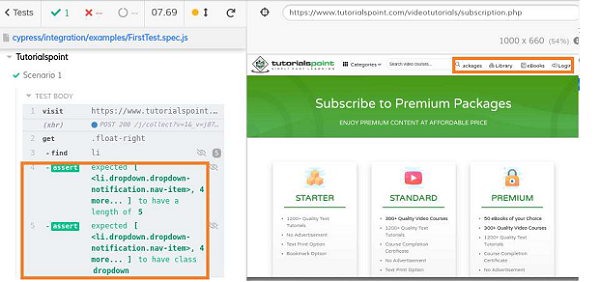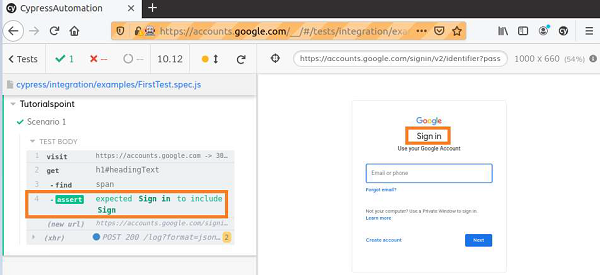
- Cypress - Home
- Cypress - Introduction
- Cypress - Architecture and Environment Setup
- Cypress - Test Runner
- Cypress - Build First Test
- Cypress - Supported Browsers
- Cypress - Basic Commands
- Cypress - Variables
- Cypress - Aliases
- Cypress - Locators
- Cypress - Assertions
- Cypress - Text Verification
- Cypress - Asynchronous Behavior
- Cypress - Working with XHR
- Cypress - jQuery
- Cypress - Checkbox
- Cypress - Tabs
- Cypress - Dropdown
- Cypress - Alerts
- Cypress - Child Windows
- Cypress - Hidden Elements
- Cypress - Frames
- Cypress - Web Tables
- Cypress - Mouse Actions
- Cypress - Cookies
- Cypress - Get and Post
- Cypress - File Upload
- Cypress - Data Driven Testing
- Cypress - Prompt Pop-up Window
- Cypress - Dashboards
- Cypress - Screenshots and Videos
- Cypress - Debugging
- Cypress - Custom Commands
- Cypress - Fixtures
- Cypress - Environment Variables
- Cypress - Hooks
- Cypress - Configuration of JSON File
- Cypress - Reports
- Cypress - Plugins
- Cypress - GitHub
- Cypress Useful Resources
- Cypress - Quick Guide
- Cypress - Useful Resources
- Cypress - Discussion
Cypress - Assertions
Cypress has more than one type of assertions obtained from various libraries like Mocha,Chai, and so on. The assertion types are explicit and implicit.
Implicit Assertions
If an assertion is applicable to the object obtained from the parent command in a chain, it is known as the implicit assertion. The popular implicit assertions include .and/.should.
These commands cannot be used as standalone. Generally, they are used when we have to verify multiple checks on a particular object.
Let us illustrate implicit assertion with an example given below −
// test suite
describe('Tutorialspoint', function () {
it('Scenario 1', function (){
// test step to launch a URL
cy.visit("https://www.tutorialspoint.com/videotutorials/index.php")
// assertion to validate count of sub-elements and class attribute value
cy.get('.toc chapters').find('li').should('have.length',5)
.and('have.class', 'dropdown')
});
});
Execution Results
The output is as follows −

The output logs show two assertions obtained with should, and commands.
Explicit Assertions
If an assertion is applicable to an object directly, it is known as the explicit assertion. The popular explicit assertions include assert/expect.
The command for explicit assertion is as follows −
// test suite
describe('Tutorialspoint', function () {
// it function to identify test
it('Scenario 1', function (){
// test step to launch a URL
cy.visit("https://accounts.google.com")
// identify element
cy.get('h1#headingText').find('span').then(function(e){
const t = e.text()
// assertion expect
expect(t).to.contains('Sign')
})
})
})
Execution Results
The output is given below −

The output logs show assertions directly applied to objects with the expect command.
Cypress has Default Assertions which are internally handled and do not require to be invoked specifically.
Few examples are as follows −
cy.visit () − Expects the page to show the content with 200 status code.
cy.request () − Expects the remote server to be available and sends a response.
cy.contains () − Expects the web element with its properties to be available in DOM.
cy.get () − Expects the web element to be available in DOM.
.find () − Expects the web element to be available in DOM.
.type () − Expects the web element to turn to a type able state.
.click () − Expects the web element to turn to a clickable state.
.its () − Expects for a web element property on the existing subject.
Other Cypress assertions
The other Cypress assertions are as follows −
length
It checks the count of elements obtained from the previously chained command.
For example,
cy.get('#txt-fld').should('have.length',5)
value
It checks whether the web element has a certain value.
For example,
cy.get('#txt-fld').should('have.length',5)
class
It checks whether the web element possesses a certain class.
For example,
cy.get('#txt-fld'').should('have.class', 'txt')
contain
It checks whether the web element possesses a certain text.
For example,
cy.get('#txt-fld'').should('contain', 'Cypress')
visible
It checks whether the web element is visible.
For example,
cy.get('#txt-fld'').should('be.visible')
exist
It checks whether the web element is available in Document Object Model (DOM).
For example,
cy.get('#txt-fld'').should('not.exist');
css
It checks whether the web element possesses a certain css property.
For example,
cy.get('#txt-fld'').should('have.css', 'display', 'block');